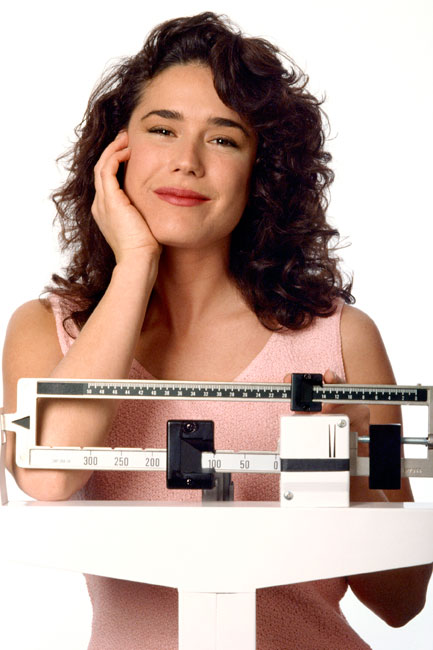A Healthy Twist on Traditions
Tipping the Scales in Your Favor
A Carolina Woman 90's Flashback
To celebrate our 15th anniversary, each month Carolina Woman reprints one article from the first year we hit the streets of the Triangle. When the author wrote this article, she was a nutritionist at the Sarah W. Stedman Center for Nutritional Studies at Duke University Medical Center in Durham. Fifteen years later, local women still crave healthy ways to make it through the holidays.
Why does the last month of the year signal the downfall of willpower for so many of us?
Perhaps it is because it signals a time of freedom from restriction. Until the first of the year, we indulge in food, socializing and shopping. Then comes the new year, and with it all those resolutions to lose weight gained during the holiday season.
Maybe there is a better way. Maybe there is a way to enjoy the holiday season without dieting for the rest of the winter.
What would happen if you celebrated this season with a new twist — a bent toward making the foods served and kept in your home and office a little healthier? After all, small steps on a daily basis can go a long way toward big health dividends.
Let’s take a look at some easy steps toward health in terms of food preparation, food choices and keeping your energy level up.
First, examine how you can attain this health “twist.” Make a list of the foods or situations you feel are a problem for you during this time.
| Problem Food or Situation | Some Alternative Ideas |
|---|---|
“I have such a hard time with all of the candy and cookies everybody’s got at work.” |
Think of foods you like that are nutritious as well as delicious, such as a bowl of fruit or low-fat chocolate pudding. Aim for eating five servings of fruits and vegetables a day. If you want the candy and cookies, have them after you’ve had your five fruits/veggies so empty calories don’t end up replacing nutritious ones. |
“I always end up drinking too much alcohol at the parties.” |
Try lighter versions of beverages (for example, spritzers), drink diet soda or hang on to an empty glass. |
“My favorite holiday foods are high in fat and calories.” |
Try one or two modifications on each recipe to decrease the fat content. Remember, you can almost always cut out half the fat in baking and replace most of it in cooking. |
“I always feel tired and stressed during the holiday season.” |
Plan naps, schedule getting to bed 30 minutes earlier at night, plan at least one night every two weeks to go to bed really early (for instance, 9 p.m.), take a 20-minute walk during the day, and choose your activities. Ask yourself: “Do I have to do absolutely everything?” |
Maybe it’s the candy or cookies at the workplace. Maybe it’s your favorite foods at a holiday meal. Maybe you always feel exhausted during the holidays.
For every problem, there are several possible solutions so some brainstorming is in order. On the next page is a chart of some common challenges and a few ideas on how to turn them to the positive. Add your own holiday challenges to the list and then think of some steps you can take to gain the health advantage.
If your holiday meal lineup is loaded with fat and cholesterol, how about trying some new dishes this year?
There are healthy cooking magazines and books galore available at just about any bookstore. A little research can reveal some new and healthy favorites for you and your family.
However, some people want their favorite dishes at holidays – no matter what. It’s a good thing that changing a recipe is so easy.
In cooking, you can replace most to all of the fat with broth, water or wine. This makes for a particularly exceptional lower-fat dish when you are sauteing foods or adding for moisture, as in bread stuffing.
For stuffing-like dishes, using fruit (for instance, canned pineapple) can also help the dish stay moist without adding all that fat.
The holidays are also a popular time for baking, which often means using loads of fats such as butter, shortening, oil and margarine. In general, you can cut out one-half to three-fourths of the high-fat ingredients from baked items and replace them with applesauce, buttermilk, yogurt or molasses.
You’ll probably have to experiment a little bit with these substitutions, but in general they work as follows: In a recipe calling for two sticks (one cup) of butter or margarine, replace the butter with one-half stick (one quarter cup) of the fat and three-quarters of a cup of applesauce.
Your final product will taste just about the same as the original, and you will have saved 180 grams of fat. That’s 1,620 calories just from fat in that baked item that you will have avoided.
Low-fat buttermilk or non-fat yogurt can replace higher-fat milks, and you can cut down on fat by adding a few tablespoons of molasses or honey to make up the difference. Note that your product will be a little more dense than the original because it will hold more moisture.
During the holidays, eating right, sleeping well and getting exercise are especially important if the only energy crisis you are worried about is the one in your body.
During this time, people tend to grab food on the run, stay up later and run around doing more errands. Unfortunately, eating a high-fat, fast-food diet, skipping meals (particularly breakfast), missing sleep and sacrificing exercise for errands are a recipe for even more stress!
It is more important than ever to take the time to get enough sleep, relaxation and exercise. If you are physically tired, it will be harder to tell if you are physically hungry.
Many people eat to get more energy, but that will just make them more tired in the long run. Yes, it is important to eat when you are hungry. Hunger is a vital message the body sends you.
However, eating to boost your energy level when you are tired – not hungry – is like filling your car with gas when it actually needs a tuneup. Although your car needs gas to run, it won’t replace the need for new spark plugs or a fan belt. If you are overrunning, you need more rest and relaxation, not more chocolate chip cookies.
Just like you plan your errands, plan some free time and some sleep time. Choose your activities because no one can do it all and do it well.
During really stressful times, try to plan a night every two weeks or so when you can let your body really sleep. Crawl into bed at 9:30 p.m. instead of 11:30 p.m. Take a short nap – 30 minutes should do it. (If you sleep for more than an hour, you run the risk of interrupting your nighttime sleep patterns.)
Ask yourself before you eat if you are hungry or tired. If you are tired, remember that food may give you a momentary boost at best.
The holidays can be loaded with fun and challenges. To make the most of the fun and minimize the risk, remember that small steps, like the ones suggested here and the ones you thought of, can yield big results in the new year.
The Facts on Fats
Congratulations – you’ve decided to celebrate the holidays healthfully.
Now where do you turn for advice and information?
Nutrition is big news these days, but despite all the articles, books and television shows, it can be challenging to overcome the hazards of misinformation and misrepresentation.
For example, just about everybody has heard about cholesterol. But wait – is cholesterol the stuff in your blood or the stuff on your plate? And how do you tell the difference anyway?
Getting the straight scoop on cholesterol and fat can be pretty slippery at times. So once and for all, let’s set the record straight with the skinny on fats – both inside and out.
The inside skinny
Let’s get one thing straight: Cholesterol is not a fat. It is a waxy, fat-like substance.
Cholesterol is one of the major building blocks of your body, involved in cell-wall structure and steroid hormones – so it is pretty important stuff.
So important, in fact, that your body does not trust that your diet will provide enough of it for you to function. Therefore, your liver makes it.
Of course, some people get plenty of cholesterol in their diets and their livers absolutely go to town when it comes to making the stuff. And this is generally where they begin to get into problems.
When the amount of cholesterol in your blood is high, you have a greater tendency for the fats in your blood to get stuck up against the walls of your blood vessels. Blood vessels are generally smaller than a pencil, so a little bit of clogging goes a pretty long way.
The general idea here is to have your cholesterol be in lower, rather than higher, concentrations in your blood (less than 200 milligrams per deciliter). High levels of blood cholesterol are associated with an elevated risk of heart disease.
If you don’t know your cholesterol level, have your physician or health clinic check.
Blood (also called serum) cholesterol breaks down into a few different parts. When you put blood into a test tube and spin it really fast, big fluffy particles separate from the smaller, denser ones.
This is rather like comparing cotton balls to ball bearings. The “cotton-ball” fats are called LDL cholesterol, which stands for low-density lipoprotein (“lipoprotein” means fat plus protein). The “ball bearing” fats are called HDL cholesterol, which stands for high-density lipoprotein.
Although both of these fats work much like a taxi service, they go in opposite directions. The LDL cholesterol “chauffeurs” fat from the food you’ve eaten to places of storage (such as your hips, stomach and other strategic spots you might rather not have it) and is responsible for laying down fat and cholesterol in your arteries.
In your body, HDL cholesterol chauffeurs fat from places of storage to your muscles, where the fat is burned for energy. In your blood vessels, HDL works like a roto-rooter in that it essentially cleans out the gunk in the pipeline.
Take your pick: Would you rather have lots of LDL or lots of HDL? Fat storage or fat burning?
If your LDL cholesterol is high, your risk for developing heart disease is probably high as well. Conversely, if your HDL is high, you are probably in fair physical shape with relatively less risk of developing heart or cardiovascular disease.
To illustrate this, pick up a straw. A regular drinking straw is about the size of a pencil, which is also the size of a large blood vessel in your body. Now roll a ball bearing through it. Easy, huh? Then try shoving a cotton ball through it.
Get the picture? If you want to avoid heart disease, you want to have low LDL and high HDL cholesterol.

The outside skinny
You may know that fat has a lot of calories. But did you know that cholesterol is calorie-free?
Cholesterol is not a fat, but a waxy, fat-like substance that doesn’t break down (no breakdown means no calories). You do absorb it relatively intact, so the cholesterol in your diet can influence the cholesterol in your blood.
Remember, just as cholesterol is made by your liver, only food that once had a liver or that comes from an animal with a liver (such as ice cream and cheese) can have cholesterol.
Of course, what becomes a little more slippery are the fats that you can break down. And boy do Americans break down a lot of them.
Fats come in three basic kinds: saturated, polyunsaturated and monounsaturated.
The saturated fats are so saturated that they are stiff. In general, they are the ones that are solid at room temperature (butter, hydrogenated vegetable shortening, stick margarine, animal fats and tropical fats). We can also add to this list the butterfats found in whole and two-percent milks and whole-milk cheeses.
Somehow, it is these saturated fats that seem to tell your liver to produce more cholesterol. It may not be the cholesterol you eat that really raises your blood cholesterol but the saturated fat instead.
The other two types of fats are thought to be far healthier when used in moderation: polyunsaturated (corn, sunflower and safflower oils) and mono-unsaturated (olive, sesame, canola and nut oils).
These fats are generally liquid at room temperature, like cooking oils and liquid margarines, but there are some exceptions. The fats in avocado, which are mostly monounsaturated, are obviously solid.
It is currently thought that switching from a diet high in saturated fats to a moderate-fat diet with mostly unsaturated fats will help reduce your blood-fat levels.
Now that you have the skinny on fats inside and out well in hand, you can cast a discriminating eye on the nutrition advice that comes your way.



